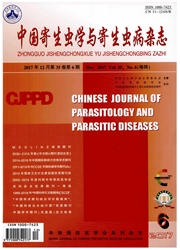

 中文摘要:
中文摘要:
目的 了解广东省南澳岛广州管圆线虫(Angiostronglyus cantonensis)中间宿主福寿螺(Pomacea canaliculata)和终末宿主鼠类的分布密度及感染现状。 方法 于2015年12月-2016年9月采用分层随机抽样法分别从南澳岛抽取宫前村、金山村、六都村等3个行政村作为调查点。采集福寿螺、捕获鼠类,GPS仪记录各采样点的数据。福寿螺经形态学鉴定后,提取基因组DNA进行PCR检测复核螺种。福寿螺感染情况先用肺检法检测肺囊,再用酶消化法和匀浆法检查螺肉和肺囊。鼠类经形态学初步鉴定鼠种及性别后,再解剖采集肝脏用于PCR检测复核鼠种,剖检心、肺组织检查有无广州管圆线虫成虫感染。采集到的广州管圆线虫经形态学鉴定后,再进行PCR检测鉴定虫种。采用SAS9.3统计学软件对福寿螺、鼠类密度和感染情况进行统计分析。 结果 共采集福寿螺2 192只,随机选取1 190只用于检测,其中阳性螺72只,阳性率为6.1%。共捕获鼠类110只,包括褐家鼠(Rattus norvegicus)、黄胸鼠(R. flavipectus)、黄毛鼠(R. losea)和臭鼩(Suncus murinus)4个鼠种,其中阳性鼠32只,感染率为29.1%(32/110),褐家鼠感染率为36.5%(31/85),黄胸鼠有1只感染,黄毛鼠和臭鼩均为阴性;福寿螺和鼠类线粒体DNA细胞色素氧化酶Ⅰ亚基(COⅠ)扩增片段长度分别约670、706 bp,广州管圆线虫核糖体DNA内转录间隔区2(ITS2)扩增片段长度约693 bp,与预期大小相符。不同季节福寿螺密度(H = 11.603 5, P 〈 0.01)和感染率(χ^2 = 65.1 441, P 〈 0.01)差异均有统计学意义,不同季节鼠的密度差异也有统计学意义(H = 19.268 2, P 〈 0.01);河道环境福寿螺密度最高(8.8只/m^2),但不同孶生环境下福寿螺的密度差异无统计学意义(H = 3.909 3, P > 0.05)。沟渠环境福寿螺平均感染率最高(7.5%,42/429),且福寿螺和鼠类感染
 英文摘要:
英文摘要:
Objective To investigate the densities of Pomacea canaliculata and rodents, as well as their infection status with Angiostronglyus cantonensis in Nanao Island of Guangdong Province, China. Methods Stratified random sampling was made in three villages(Gongqian village, Jinshan village and Liudu village) in Nanao Island from December 2015 to September 2016. P. canaliculata and rodents were collected and the sampling sites were mapped by GPS. For P. canaliculata, morphological observation was performed, followed by DNA extraction and PCR to double-check the species. Infection in P. canaliculata was examined by lung-microscopy, tissue homogenate and enzyme digestion. For rodents, morphological observation was first performed to identify species and sex, and the species was further confirmed by PCR on DNA from the liver tissue. The heart and lung were dissected to inspect A. cantonensis infection. Morphological examination and PCR were performed to determine the species of the collected samples of parasite. Data were analyzed by using SAS9.3 software. Results Totally 2 192 P. canaliculata were collected and 1 190 were selected for examination. Of them 72(6.1%) were positive for infection. 110 rodents were captured, consisting of the species of Rattus norvegicus, R. flavipectus, R. losea and Suncus murinus. Of them 32(29.1%) were positive for infection, consisting of 31 R. norvegicus and one R. flavipectus. The other two species showed negative results. As expected, the length of COⅠ amplification products was 670 bp and 706 bp, respectively, for P. canaliculata and rodents, while the length of ITS2 for A. cantonensis was 693 bp. There was a significant difference in density(H = 11.603 5, P 〈 0.01) and infection rate(χ^2 = 65.144 1, P 〈 0.01) in P. canaliculata among different seasons. There was also a significant seasonal difference in the density of rats(H = 19.268 2, P 〈 0.01). P. canaliculata from rivers had the highest density (8.8/m^2), while those from irrigation canals and d
 同期刊论文项目
同期刊论文项目
 同项目期刊论文
同项目期刊论文
 期刊信息
期刊信息
